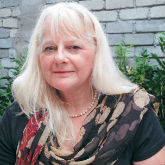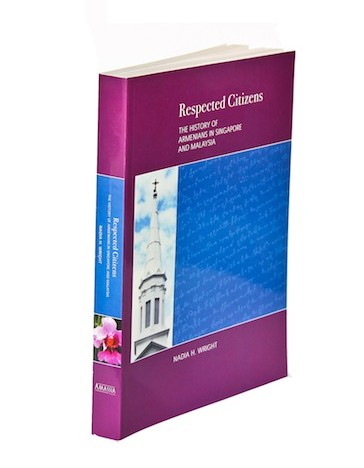The Armenian Legacy in Penang


Although the Armenian community in Penang was always small, it nevertheless played a decisive role in shaping the island’s history. Frances Wilks met Dr Nadia Wright, author of Respected Citizens: The History of Armenians in Singapore and Malaysia, when she visited Penang recently.
Like many people, I had originally thought that one of the most famous streets in George Town, Armenian Street, was a tribute to the Armenians of Penang. But actually it has little to do with them, as Nadia Wright told me, “The name just refers to the fact that an Armenian had a house on the corner of the street. There are far more impressive monuments to the Armenian legacy, including several street names, as well as the E&O Hotel where we’re sitting now, and, of course, Clove Hall, the former home of the Anthony family.”
See Also: Ode to Armenian Street
Nadia Wright first came to Singapore from Australia in the 1980s as an expat when her husband was posted there. She was delighted to have the time to research the Armenian community in Singapore and Malaysia, particularly as she had had an Armenian mother, born in Egypt but who died in New Zealand. Her book, Respected Citizens, is an extremely well-researched account of the families who made up the Armenian community in this part of Southeast Asia.
The Roots of the Armenian People and Early Days in Penang
Armenia, a small landlocked country bordered by Turkey, Iran, and the Caucasus, is an ancient land which was actually the first country in the world to adopt Christianity – just a little ahead of the Roman Empire – in around 301 CE. Situated on one the great trade routes of the world, the Armenians developed considerable expertise in international trading, as well as in traditional arts such as gold and silver work. So much so that the 17th-century Shah Abbas of Persia persuaded 25,000 of them to leave their country and settle in Isfahan where they founded New Julfa (the old Julfa being in Armenia). Later still, The Emperor Akbar invited them to India where they settled in Bombay and Madras and then fanned out to Malacca, Singapore, Batavia, and, of course, Penang.
Armenians came to Penang in the early days of its foundation – though their small numbers belied their noticeable presence in the economic, social, and civic life of the colony. Initially, perhaps a dozen merchants became prominent – men such as Carapiet Arackell, Catchatoor Galastaun, and Arratoon Anthony. (The last, who was a trader and a planter, celebrated to this day in the street name of Arratoon Road, off Burmah Road.) The company he founded survives to this day as the stockbrokerage A.A. Anthony. It is thought that Arratoon Anthony was the original owner of the Anglo-Malay house, Clove Hall. It’s now beautifully restored as a boutique hotel along Jalan Clove Hall, very near Arratoon Road. The splendid exterior and the exquisite interior speak eloquently about the taste and dignity the Armenian community possessed. The present-day owners of the hotel, Jo and Jim Lim, are keen to research the history of the house when they have some spare time from running it.
St Gregory and the Singapore Connection
The end of the 19th century was marked by the arrival of the Sarkies brothers, well known as hoteliers throughout Southeast Asia, and Dr Avetoom, the founder of the George Town Dispensary, all of whom became leading fi gures in Penang Society. Despite their small numbers, the Armenians were engaged citizens. For example, they built a church dedicated to St Gregory the Illuminator on Bishop Street. When the church was demolished in 1909, an elegant monument took its place but only this photograph remains, as the monument and its garden were cleared in the 1930s to make way for development.
One way to imagine what the church would have been like is to visit the Church of St Gregory the Illuminator in Singapore, gazetted a national monument in 1973. The picture of an Armenian priest in full regalia comes from this church. His gorgeous robes and headdress give an idea of the exotic designs and colours used in the Armenian culture. And there’s another connection between the Penang Armenian Church and the Singapore Armenian Church. When St Gregory’s Penang was demolished, the church’s plaque was sent to St Gregory’s Singapore.
The Sarkies Brothers
Penang would not be Penang without the E&O Hotel, and its fl amboyant founders, the three Sarkies brothers – Tigram, Arshak, and Martin – were, of course Armenians. Part of the culture of Armenia is, according to Nadia Wright, a love of entertaining, good food and wine, song and dance, all of which make them potentially excellent hoteliers. I was intrigued to fi nd out that the Sarkies brothers didn’t own the original hotel, but rather leased it.
The Sarkies also founded the Strand Hotel in Rangoon and the Raffl es Hotel in Singapore, as well as the Crag Hotel on Penang Hill which in the 1950s became the first home of the Uplands School. Sadly because of the failure of their patrons to pay their bills, coupled with their legendary generosity (one example of which was providing passages home for stranded planters), they went out of business in the 1930s. Just before this, Arshak of the Sarkies brothers had overseen a magnificent restoration of the hotel, including the opening of a new wing and the construction of the famous rotunda in 1929.The present day E&O Hotel is under a different ownership, though the brothers are immortalised in the name of the one of the hotel’s restaurants, Sarkies. Most of the Armenian community left Penang between the World Wars of the 20th century for other countries, such as Australia and Canada. Although they are no longer a force in Penang life, they have left a rich cultural legacy, an important strand woven into the Penang Story.
Respected Citizens: The History of Armenians in Singapore and Malaysia by Nadia Wright is available from Areca Books.
Source: Penang International February/March 2014
Read more:
- Are Malaysians Slowly Learning to Adopt a Do-It-Yourself Attitude?
- 10 Islands You Want to Visit in Malaysia
- The Story Behind Penang’s Rat Island (Pulau Tikus)
What are your thoughts on this article? Let us know by commenting below.No registration needed.
"ExpatGo welcomes and encourages comments, input, and divergent opinions. However, we kindly request that you use suitable language in your comments, and refrain from any sort of personal attack, hate speech, or disparaging rhetoric. Comments not in line with this are subject to removal from the site. "



















